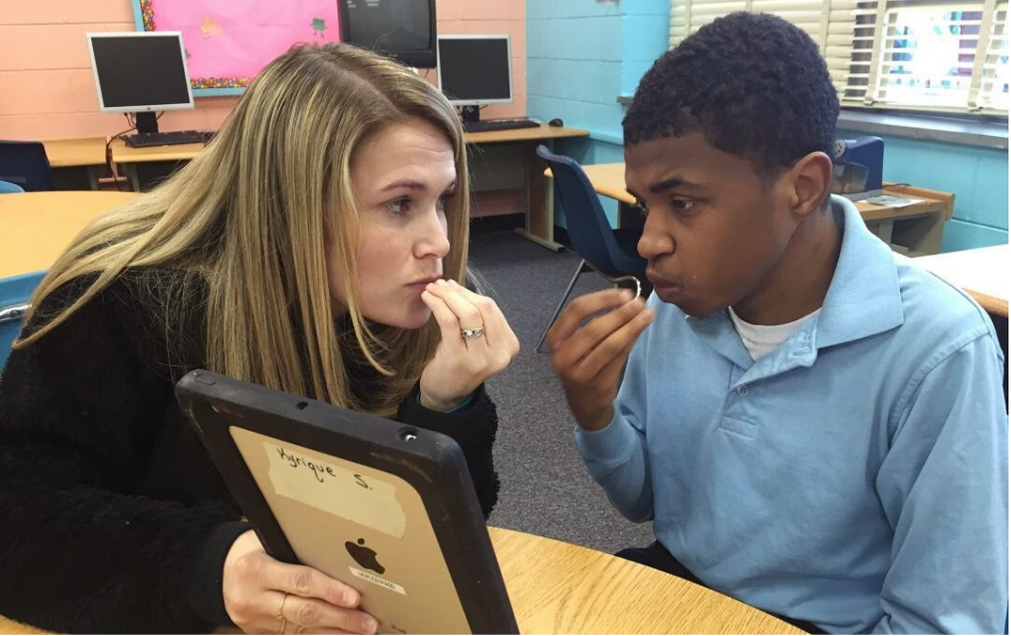Lesson 3 - Foundational Teaching Strategies
In this lesson, we turn our attention to strategies you can use in educational settings or at home with a child who is deafblind. Discover effective techniques for engaging a child in meaningful conversations and interactions that promote communication development. And learn how to use one of the most important techniques for working with a child who is deafblind: Hand-Under-Hand.
For more information, visit the National Center on Deaf-Blindness at nationaldb.org.

Learning Objectives
Lesson 3 has 3 learning objectives. After completing the lesson, participants should be able to
- Describe how to prepare for and initiate an interaction with a child who is deafblind
- Use strategies that engage a child who is deafblind in mutual interactions
- Demonstrate the appropriate use of the hand-under-hand technique with a child who is deafblind
Part 1 - Promoting Effective Interactions
In Part 1, you will learn why building trust and creating strong relationships with others are critically important for children who are deafblind.
Activities
Option 1
Read the factsheet Choosing and Using Tactile Name Cues, by Maurice Belote from California Deafblind Services. Then, spend some time coming up with your own personal identifier or name cue.
Option 2
Review this likes/dislikes form from Washington Sensory Disabilities Services. Pick three categories (e.g., foods, smells, touch), and fill it out based on a child you know (can be deafblind or hearing-sighted).
Option 3: Collaborative Activity
Imagine that you are working with a young child who is deafblind, and you have a good idea of the child’s preferences (e.g., loves to eat, enjoys music, likes slippery textures). Working with your teammates, select a preference. Then, create an activity to teach a math-related skill, such as counting, sorting, or ordering that takes advantage of the child’s preferences. To make this option more challenging, develop a list of the collaborative teammates, a thorough description of the selected activity, and the connections to student preferences.
Part 2 - Basic Strategies for Encouraging Interaction
Part 2 provides specific strategies you can use right away to start bonding and building trust with a child who is deafblind.
Activities
Option 1
Watch this video of a young child who is deafblind and her father. What strategies do you see the father using to encourage her to interact with him? How does the child respond to these strategies?
Option 2
You learned in this lesson that a child who is deafblind is often the recipient of one-way directives. Turn-taking shows them it doesn’t always have to be that way. Write a short essay that explains why the turn-taking strategy is so important to use with children who are deafblind, and what it teaches them about interacting with others.
Part 3 - The Hand-Under-Hand Technique
In Part 3, you’ll discover how to connect and communicate with a child as you gently guide and support their learning using the hand-under-hand technique.
Activities
Option 1: Collaborative Activity
Working with your partners, choose a tool that a child who is deafblind can learn how to use (e.g., a hammer, scissors, a ladle, a measuring cup). Brainstorm ways you might introduce the tool to the child. Make sure to consider their developmental age when selecting a tool and determining how you’ll introduce it to them.
Option 2
Alone or with partners, watch this video of a teacher working with a child who is deafblind as she encourages him to prepare and serve lunch for his classmates. Write a paragraph or make a list of the things you see the teacher doing to support this child’s learning.
Option 3
Imagine that you are working with a toddler or older child who is deafblind. You know from reviewing prior documentation and talking with the family that the child is sensitive about being touched. This may be due to having multiple medical procedures when very young and perhaps memories of having their hand movements restricted. Write a short essay that describes how a teacher can sensitively interact with the child using hand-under-hand.
Quiz
Instructors are welcome to use this quiz as-is or adapt it to meet their needs. It can be used to test participants’ knowledge following completion of the module or for pre- and post-test evaluation. To obtain answers to the quiz, instructors should contact support@nationaldb.org.
Additional Resources
Building Communication Through Conversation
Resources on how to have conversations with children who are deafblind, no matter their current level of communication
Deafblind Interaction
A website from the Texas Deafblind Project on quality social interaction techniques and models for communication with children who are deafblind
Turn-Taking Play Strategies
From the Texas Deafblind Project, this webpage provides information about turn-taking, including how hand games, object games, auditory games, and shared activities can be used to develop a bond with a child
Hand-Under-Hand Technique: NCDB Practice Guide
A list of the skills a teacher or other adult working with a child or youth who is deafblind would display if implementing hand-under-hand strategies correctly
Hand-Under-Hand Interactions
Information on how to use hand-under-hand strategies to support a child's learning, development, and quality of life
